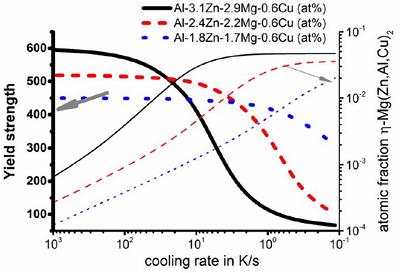In processing of heat treatable aluminium alloys, such as the Al–Zn–Mg (7xxx), Al-Mg-Si (6xxx) and Al–Li–Cu based alloys, the quenching is a crucial stage. This is due to the formation of precipitates during (relatively) slow quenching which are generally detrimental to properties such as toughness, stress corrosion cracking resistance and yield strength. In this project, models for quench sensitivity have been derived which predict the relevant properties of the processed alloys. Models for 6xxx and 7xxx Al alloys covering the entire range of commercial alloy composition have been produced and are available for use in industry. Variables in the models are the cooling rate and composition of up to 6 elements. The models have to date been verified by comparison to ~1000 data points from tensile tests, hardness tests, DSC, TEM and SEM for a wide range of alloys.
Slow quenching decreases the amount of solute that is available in the matrix for subsequent age-hardening due to the formation of coarse, non-hardening quench-induced precipitates. This results in a reduction of the final mechanical properties, which can be the main limiting factor in application of the alloy. Precipitation on defects such as grain boundaries during quenching is in practice nearly unavoidable for all medium and high strength heat treatable aluminium alloys, and the quench sensitivity generally increases with increasing content of main alloying elements. Also the minor alloying elements Zr, Mn and Cr, which form intermetallic particles of sizes typically in the range of 10–100 nm (generally termed ‘dispersoids’), strongly influence the quench sensitivity as those dispersoids will act as nucleation sites for the quench-induced phase.
The model incorporates a recently derived model for diffusion-controlled reactions based on the extended volume fraction concept as well as recent findings from first principles modelling of enthalpies of the relevant phases. The model shows a near perfect correspondence with data on a wide range of alloys, and allows prediction of the influence of the 3 major elements and 3 dispersoid forming elements on quench sensitivity.
Influence of quench rate on yield strength (T6) and amount of η quench-induced precipitates for three 7xxx alloys with varying Zn and Mg content and constant Zn:Mg ratio.
